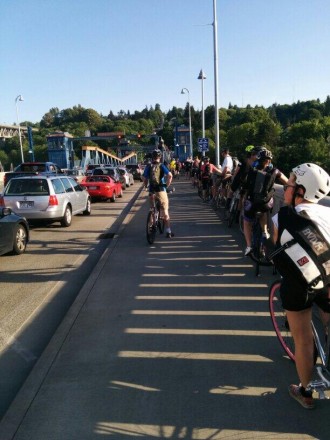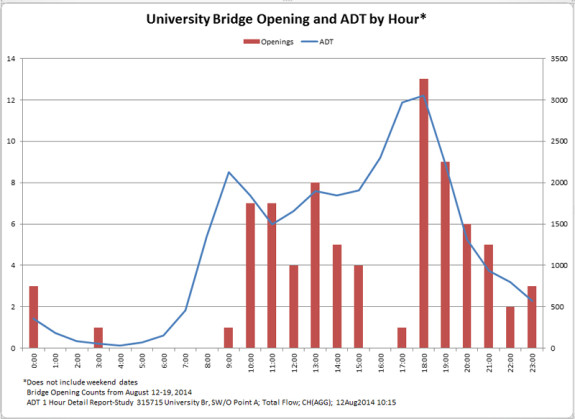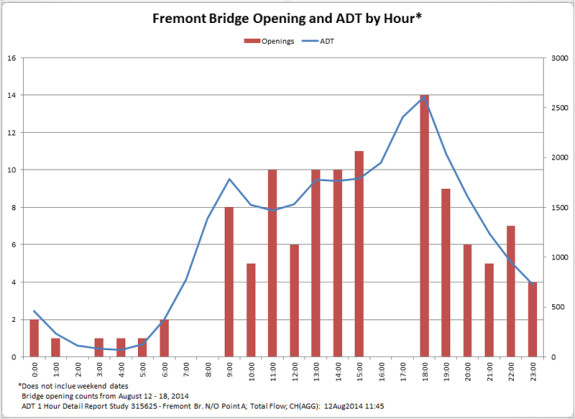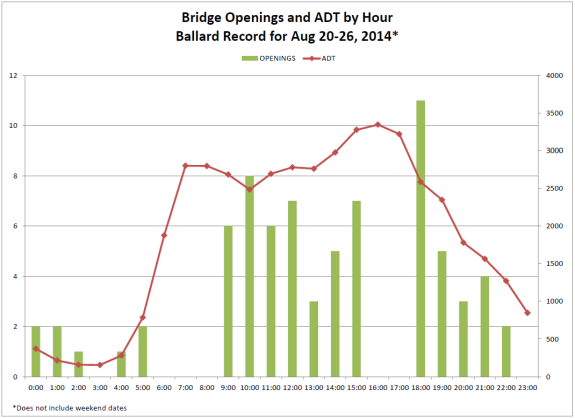
Getting stopped for a draw bridge is one of those truly Seattle experiences, especially for people on bikes. Three of the busiest bike route chokepoints in the city are bridges that open for maritime vessels: Fremont, University and Montlake Bridges.
Being on a bike lets you bypass the traffic backup and get up close to the action. Watching boats pass by is a chance to take a break and contemplate our beautiful city.
Which is all fun and games so long as you aren’t running late. Or getting soaked in the pouring rain.
And, of course, all the bus routes that use the draw bridges get thrown off-schedule and stuck in big traffic jams. And despite signs telling people to cut their engines, the number of idling cars waiting for bridges is awful for air quality and the environment. Thousands of people add minutes to their travel times, an effect that adds up fast during busy hours.
And those busy travel hours keep expanding as the city grows, bursting out of the two-hour windows during the morning and evening commutes when the city is not required to raise the bridges except for large commercial vessels.
So the city is conducting outreach now in an effort to change Coast Guard rules to limit the number of times draw bridges open for recreational water craft during busy travel hours. SDOT Director Scott Kubly told the Seattle Times that a schedule for “pleasure craft” openings could limit the number of openings.
“The pleasure craft, we want to have scheduled openings so people in their boats know when to show up, and motorists can plan accordingly,” he told the Times.
 I suppose anyone wanting to watch the bridge open would also know when to show up. And perhaps buses could be scheduled to avoid openings, as well. Or maybe the bridge operators could even hold the bridges for buses. And bike travel times — which are already more predictable than driving or taking transit during busy hours — would be even more predictable.
I suppose anyone wanting to watch the bridge open would also know when to show up. And perhaps buses could be scheduled to avoid openings, as well. Or maybe the bridge operators could even hold the bridges for buses. And bike travel times — which are already more predictable than driving or taking transit during busy hours — would be even more predictable.
A simple bridge rule change is also one of the most cost-efficient ways to significantly improve movement of people and goods around the city.
My main questions remaining are: Will the Coast Guard and laws governing waterways look kindly on the changes? And would scheduling bridge openings lose something inherently Seattle: Sometimes without warning, the city makes you stop, dismount and gaze out at the lake.
SDOT owns and operates three of the four bridges that span the Ship Canal – Ballard, Fremont, and University. (The Montlake Bridge is owned and operated by the Washington State Department of Transportation.)
The Ship Canal itself is defined by federal law as a navigable waterway, making each of these bridges subject to federal oversight. It is the US Coast Guard that many years ago gave SDOT (and WSDOT) the authority to limit the openings of these bridges on weekdays from 7-9 AM and 4-6 PM. (The exception is for large commercial vessels of 1,000 tons or more, for which the bridges must always open upon request, regardless of the time of day.)
While the number of bridge openings has remained fairly constant in recent years, the impact of the bridge openings themselves has grown. The morning and afternoon commutes have gotten longer, and traffic volumes have increased as Seattle’s population has grown.
With the average bridge opening lasting five minutes, literally hundreds of cars get backed up for each opening. The more cars, trucks, and buses backed up, the longer it takes for them to clear. Buses run behind schedule, emergency vehicles at times are delayed, commuters take longer to get to work and back home, and many of the delayed motorists leave their engines running, spewing polluting emissions into the atmosphere.
As you can see from the graph of openings at the Ballard Bridge for one week of last August, the number of bridge openings is greatest at the same time vehicular traffic is heaviest. For example, during the period from 6 to 7 PM, there were 11 weekday bridge openings that week, or an average of two each day. (Approximately 61% of Ballard Bridge openings in August, 2014 were for sailboats.) During that same one hour period each day, some 2,600 vehicles crossed the bridge. The end result is backups that often extend as far south as Dravus and as far north as 65th, delays that take considerable time to clear, sometimes clearing just as the next opening is requested.
In response, SDOT is seriously considering a petition to the Coast Guard seeking a change in restrictions on when these bridges must be opened upon demand. However, before doing so, SDOT is asking the public, both the maritime community (recreational and commercial) and the land-based stakeholders whether they believe additional restrictions are warranted, and if so, what might those restrictions be.
Should you wish to share your thoughts on these questions, you are asked to submit comments by Friday, September 25. You can submit your comments to [email protected], or mail them to:
Ship Canal Bridge Openings
c/o Roadway Structures
Seattle Department of Transportation
PO Box 34996 (SMT-38-00)
Seattle, WA 98124-4996For more information, please visit: http://www.seattle.gov/transportation/shipcanalOpenings.htm










Comments
28 responses to “Would fewer draw bridge openings help your bike commute?”
Many people are still commuting home at 6PM. The rush hour window for not raising the bridges should be extended to 6:30PM. Also, I’d love car drivers to realize that a rich dude in a yacht slows them down for much longer than a bicyclist controlling the lane for a short time for safety.
I’m the worst of all… A not-rich dude who scrapes together enough money to keep his aging sailboat by biking everywhere and not owning a car! And yet, even my humble mast needs the fremont bridge raised.
Seattle’s drawbridges are functionally obsolete.
Restricting openings might be an acceptable short-term solution, but SDOT’s primary focus should be on long-term funding to replace the bridges with higher spans that more boats can pass under while closed, coincidentally providing an opportunity to construct modern sidewalks for pedestrians and suitable lanes for bicycles.
The low height of the Fremont Bridge is actually nice for walking and biking. It provides direct, flat access to important streets immediately on both sides of the canal and access to the low-lying canal-side trains that is, if not perfectly flat and direct, about as flat and direct as it could be.
By comparison, the higher Ballard Bridge only provides access to similarly located destinations and trails by moderately steep ramps. This effectively widens the canal. Ballard, no less than Fremont, has plenty of destinations at low elevation near the canal, but far fewer people walk or bike on the bridge. The Fremont Bridge and Montlake Bridge have pretty lousy sidewalks, but
If we get all the cars out of the way of the buses and ask Yachty McYachterson to wait a bit we can enjoy the advantages of our low bridges.
Actually, if we were to replace the ballard bridge with a high span, the lower span could remain and be improved to properly accomoade bikes and peds ! The high span could be for auto and transit only.
But the low span would open just as often (if not more often) than it does now.
Is that a problem?
Of course the solution in Ballard is to replace the obsolete Ballard Bridge with a high rise bridge that doesn’t need to open and includes bike lanes, sidewalks, bus lanes, light rail lanes, and of course a couple of lanes for automobiles.
But no, the openings don’t slow me down much. The opening and closing doesn’t take that long; it seems more like a long stop light. With the bridge being too hazardous to ride on and look at the scenery at the same time, it can be nice to stop mid span for a bridge opening and take in the view. The real slow downs are with all the single occupant vehicles that get backed up. On the rare days I have to drive and then get stuck in that, I sure miss being on my bike.
I don’t think there is much of a slowdown with the Ballard bridge if you are on a bike. Certainly not if you are walking. You can see the bridge opening, and slow down (as you would with a traffic light). By the time you reach the span, with any luck it is closed again. It is different for drivers, where an opening can make traffic terrible for the next fifteen minutes (you are better off getting stuck at the front of the line than arriving after it has closed).
The Fremont bridge is a little different. There is enough bike and pedestrian congestion to clog things up for a while.
Something seems strange in the Fremont and University bridge numbers, maybe an accidental lag in the ADT data?
They show that ADT peaks between 18:00-19:00 which is definitely not accurate unless something strange was going on during the week they used. I’m guessing the values should be more similar to the Ballard bridge in that the peak occurs between 17:00-18:00 and drops off afterwards.
I often cross the bridge on the 26 and related buses between 6 pm and 7 pm, and it can be jampacked all the down Dexter and Westlake both. Remember that the time it takes for SOV commuters to exit jammed parking lots in SLU or LQA as well as downtown, and then to cross things like the Mercer Mess, can mean that someone who leaves work at 5:30 may not actually get to the Fremont Bridge until well after 6. Plus, Fremont is a destination not just for those who live there, but for bars and restaurants, and people can be coming there after work to meet friends from many other places. Friday nights in particular the intersection of 34th and Fremont can look like a six lane parking lot.
The Fremont Bridge is definitely over capacity for pedestrians and bicycles. The bridge openings back up peds and bikes for the whole block- and more often that not cars are allowed to cross first. I’d say it’s time for a dedicated ped bike bridge wouldn’t you?
The car crossbar always goes up before the bike/ped crossbar- there’s that counterweight that could whack a bicyclist/pedestrian if they weren’t paying attention.
Spokane street, hello. A couple of months back it was stuck “open”, with no access for anyone, several times over. This is in addition to the regular commute time openings for maritime traffic. It’s the only route out of north and central west seattle. I’ve started taking 1st ave and regularly see “Spokane Street Bridge Closed To Traffic” reader signs. Totally unreliable and unacceptable.
Spokane Street, hello,
A couple of years ago 1st Ave S access to the high bridge to West Seattle was out of service for more than a year creating heightened reliance, particularly by Metro buses, on the lower swing bridge. The Army Corps of Engineers said they would voluntarily limit openings during rush hours for the duration, but they did not, for maritime commerce and federal law trump and what are you going to do about it?
Next up: coal trains!
The absolute worst is when University Bridge goes up at 6PM for a few slow barges, it is cold, windy, and wet, and you aren’t as prepared for the weather and stoppage as you should be.
That graph is from 2014, where the 520 bridge drawspan still opened for boats. I wonder if the frequencies of opening have changed, now that anyone with a 59’+ tall boat has had to relocate it, or leave it trapped in the South half of Lake WA.
The new bridge will have 70′ clearance, so some 59-70′ boats might return to their old homes after the old bridge is removed.
If interested, seattle DOT has a nice twitter account for looking at bridge opening data https://twitter.com/SDOTbridges
For the ballard bridge, imagine a suspension bridge tying into the existing elevated approaches at each end. The new bridge would be designed to handle light rail and auto traffic and be built directly over the existing bridge. The existing bridge approaches would be substantially shortened and drop down to connect to the streets near the water and the lanes reconfigured to properly accommodate peds and bikes. See this image: http://imgur.com/n0S949X
Where would this bridge land? Let’s see. The current draw span is 200 feet long and the bridge is about 50 feet off the water. So the new bridge would need to clear the water by more than 50 + 200/2 = 150 feet… almost as high as the Aurora Bridge (any extra clearance gets it the rest of the way to the Aurora Bridge’s 167 feet). If it goes at a 5% grade and lands at around 70 feet in elevation that’s about 2000 feet north of the edge of the draw span. That’s not far from where the current Ballard Bridge lands.
If the new approach to the old bridge is basically like the first exit from the old bridge today, it can land right right at Ballard Way; with the old elevated structure to get over Leary out of the way, Ballard Way can go through.
Sounds good to me, ship it!
I think one if the biggest issues with the bridges going up during the rush hour is the amount of traffic that blocks the cross walk. For example, the intersection of Nickerson, Florentina, and 3rd get regularly jammed up so bad that pedestrians have to travel to the middle of the intersection to cross the street because the cross walk is blocked.
Honestly, good for the boats making car traffic miserable. Hopefully the goons sitting in traffic will look at the cyclist smiling waiting for the bridge to go up as a clue to pick a different mode of transportation.
We need to stop accommodating car traffic in the city.
I’ve never understood the rationale for evening rush hour being defined as 4-6 PM
I don’t know ANYONE whose workday ends a 4pm and would be commuting from 4-5pm, while I know plenty of people who don’t get off work until 6pm and are commuting from 6-7pm.
SDOT officials need to get out from behind their desks and into the streets to get a look at how things are in the real world. There’s plenty of traffic after 6pm – made worse by SDOTs ineptitude of allowing cars to parallel park on busy arterials because it’s not some arbitrary time of day, or allowing pleasure boats to hinder the working people to get to and from work. Add in Metro’s schedule that reduces capacity when there are still plenty of people downtown who want to get home, and you’ve accounted for a considerable amount of what causes Seattle traffic to be so bad.
I have a lot of colleagues who leave at 4 so they can pick up their kids before 5.
As usual, another non-solution for the masses to consider and feel like the City is actually doing something.
Supporting this in any form is a great way to support cars and nothing else. The often overlooked fact is that the City won’t ever tell people to suck it up to those who drive, they don’t want to be held up by anything, wherether it’s a boat, bike, or a person. Just make the other users wait, yeah that’s the solution! I can’t believe people were stupid enough to vote for Murray in the first plaCE.
Take the high road pon this one and tell the City and the SDOT engineers to go hold their breath underwater below the Ballard Bridge for two minutes or so. Since oxygen seems to have no effect on their brain maybe CO2 will. Maybe they’ll pop back up with a real idea that engages the whole spectrum of transportation choices and stop being brown-nosers to the car crowd like they normally are.
The Fremont and Montlake Bridges are really important for transit, too — there’s only so high you can build a bridge that connects to the heart of Fremont or to the transfer spots on either end of the Montlake Bridge, and buses are always going to need to stop at these places.
In both locations car congestion causes more problems for transit reliability than bridge openings, but the bridge openings multiply the congestion problems. Switching a lane in each direction to bus-only would be nice, but the city isn’t likely to go for it, plus it would cause some hairy lane changes in any configuration.
Yeah, even though the Massey tunnel has counter-flow lanes in rush hour I don’t expect the City to try something like that in Seattle, it would just confuse people that much more.
The bridge height is something that has to be looked at, making them street level is preferred in my opinion as a cyclist but I guess some type of compromise has to be made depending on location.
I wish I had thought of your excellent point about car congestion alone being more of a PIA than the bridge openings, so true.
As always, I appreciate your thoughts on this and take them into serious consideration.
[…] Finally a place where cars and bikes can gang up on other people. I don’t mind waiting at drawbridges that much, but I don’t bike past a bridge for my […]
I live just south of the University Bridge, so it doesn’t affect my commute into downtown. It does sometimes make for good photo opportunities though.
https://instagram.com/p/6-Xc3mCKj0/?taken-by=zacharywil